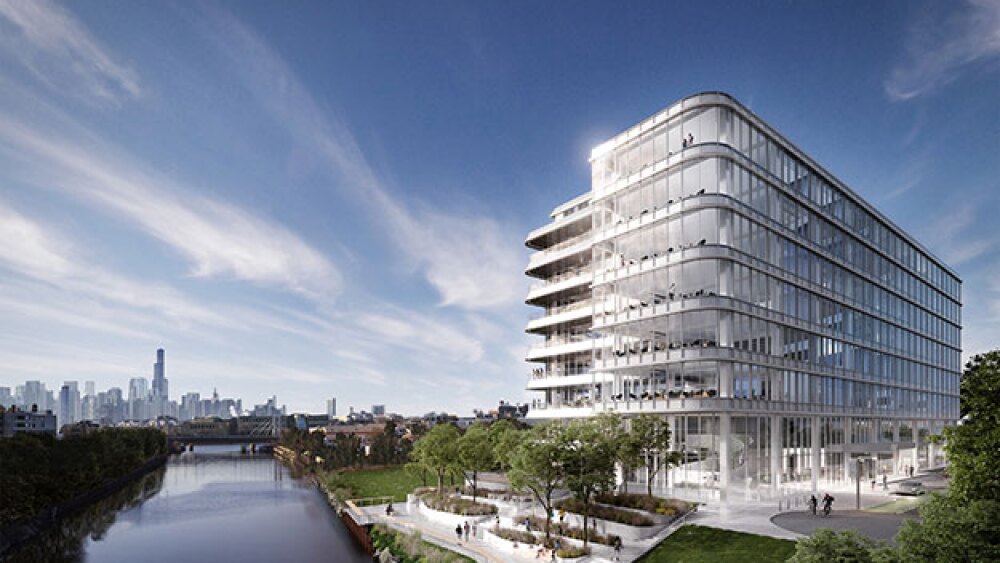Real estate development firm Sterling Bay launches life sciences division starting with Lincoln Yards, a 320,000 square foot site on the Chicago River.
An inspirational space that sparks innovation is necessary to making life-saving discoveries – or so says Sterling Bay Life Sciences, the recently formed life sciences division of one of the nation’s fastest-growing real estate development firms.
Sterling Bay, known for developing urban headquarters for the likes of Google, McDonald’s, and now Citadel, is betting big that today’s modern scientists want – and need – the same office perks that the rest of today’s workforce is demanding. Think sweeping outdoor terraces, on-site fitness centers, natural light-filled workspaces, and quick access to trendy dining and entertainment. To meet the need, Sterling Bay is converging its expertise in creative offices with its newly found knack for designing scientific spaces, building next-generation lab buildings that place scientists at the center of innovation.
The division’s latest lab development, 1229 W Concord Place, is the first building in Sterling Bay’s Lincoln Yards, a planned 53-acre development that stretches along the banks of the Chicago River. Lincoln Yards is an ambitious development that will unite some of Chicago’s most iconic neighborhoods, including Bucktown, Wicker Park, and Lincoln Park. 1229 W Concord sits adjacent to The Steelyard, what will one day serve as the cultural hub in Lincoln Yards.
Sterling Bay’s 1229 W Concord development answers a market need for innovative scientific space. The 320,000 square foot site, situated on Chicago River, provides life sciences companies ample space to develop groundbreaking and life-altering therapeutics and medical devices.
The eight-story building, designed by award-winning architecture firm Gensler, was built to inspire innovation, a critical component in the life sciences industry.
Sterling Bay broke ground on the site in 2021 and now, the company is ready for the space to become the home of local and national life sciences companies making breakthrough discoveries.
1229 W Concord includes state-of-the-art amenities and conference areas, large flexible floorplates, and expansive outdoor gathering spaces, which is something unique to this Chicago location. The space is designed to foster an environment that contributes to growth and an exchange of ideas among peers.
“Innovation is bred through collaboration – that’s true in any industry, but it’s especially true in science,” explained Dr. Suzet McKinney, Sterling Bay Principal and Director of Life Sciences. “At Sterling Bay, we focus on people-centered design and creating spaces that enable collaboration. At 1229 W Concord, we wanted to set a new standard for connected, collaborative experiences for scientists, and that’s exactly what we did. This building is unlike any other lab building in the national market – it’s a whole new product type.”
The Design
Part of what makes 1229 W Concord an inspiring space is the amount of natural light that floods each of the building’s floors. Rather than relying on artificial light to enable the scientific work that will take place on premises, the façade of the building is made entirely of glass, with floor-to-ceiling windows that allow ample amounts of natural light to enter the space. McKinney says this feature is of particular importance to tenants during the shorter days of Chicago’s winter months, when the windows will allow building residents to still be able to enjoy the sunlight during working hours.
Initial designs for the building were developed in 2020, at the height of COVID-19 lockdowns. Confined indoors while creating design concepts, the team at Gensler worked with Sterling Bay to carefully consider how the market’s progressive demand for outdoor space, as well as wellness amenities, would influence 1229 W Concord.
Final designs placed great emphasis on the building’s private tenant terraces, creating outdoor space on each floor. The building also features a high-tech space for fitness, as well as on-site conveniences like a coffee shop and space for food service. Additional amenities include spaces for various types of indoor/outdoor gatherings, such as conferences, networking events and pitch competitions, plus state-of-the-art air filtration systems that constantly circulate fresh air to prioritize tenant health.
Overall, there are eight floors available at 1229 W Concord. Each floor offers 40,000 square feet of space. In all, the building offers 285,000 square feet of rentable space.
When first entering the main floor of the building, it may seem more akin to a posh hotel than a life sciences building. The first and second floors house both the fitness center, as well as conference rooms and collaboration spaces. Like the lobby area, the collaboration space includes a mix of plush seating and high-backed chairs.
The remaining six floors have identical floor designs, with some flexibility to meet the needs of tenants. Floors three through eight include office and laboratory space bathed in natural light and designed with elbow room in mind. There is ample space between workstations, which will provide researchers with freedom of movement. Not only is that important for comfort but it will also avoid the “near collisions” many scientists experience during busy lab periods.
In addition to the natural light provided by floor-to-ceiling windows, the building includes circadian rhythm lighting that mimics the natural environment.
A Convenient, Cost-Effective Location
The location of 1229 W Concord is critical. The building is easily accessible to drivers, as well as those who take public transportation, including Chicago’s famous El system. It is also amenable to water taxi stops. The site includes 55 enclosed parking spaces.
Employees who commute on bicycles, skates, or on foot will also have an easy time entering the complex, due to the extension of The 606 trail into the development. For cyclists, there are more than 100 bike racks available for safe storage during the workday. A stepped landscaped ground floor plaza provides pedestrian and bike access to the Riverwalk extension.
Cost is also a key factor. Compared to some well-known biotech hubs in the US, the cost per square foot is significantly lower and the overall cost of living is lower. That provides a more affordable option for companies.
Beyond the floor plans, the building meets multiple rating requirements. The building achieved a Well Health-Safety Rating and a RESET rating, as well as Fitwell and LEED Silver minimum ratings. Air ducts in the Sterling Bay building are equipped with monitors to ensure appropriate quality and also hold the company accountable to the environmental ratings the construction earned.
“This is the first building of this magnitude within the city of Chicago,” McKinney said. “And sitting at the intersection of Lincoln Park, Wicker Park and Bucktown, Lincoln Yards is the place where Chicago connects.” There’s no other development with greater connectivity within the city of Chicago.
Health and Wellness in Mind
During the COVID-19 pandemic, offices across the city were largely vacant as more people worked from home or worked flexible hours in order to reduce the number of workers occupying a space at one time. Now though, the city and world has largely returned to co-sharing space. When designing 1229 W Concord, Sterling Bay wanted tenants to feel safe in the new space, so they developed the building with large, open and airy collaborative workspaces. Not only can these open and airy spaces inspire innovation and camaraderie, they foster a sense of health and wellness.
A more open design concept was key to including the private balconies on every floor. Each private balcony provides tenants with over 650 square feet of open-air space, and all have unencumbered views of the Chicago skyline.
“This is not something you see in a typical life sciences building. Coming out of COVID, people want a sense of safety and wellness. This will give people the opportunity to step outside and take in a little bit of fresh air during the workday,” McKinney said.
The building’s fitness center was designed for multiple approaches to exercise. The space includes yoga studios, as well as traditional workout equipment found in most gyms, such as stationary bikes, elliptical machines, treadmills and free weights.
Beyond the equipment itself, the exercise facility was designed with natural tones and organic materials. This was done to not only encourage a healthier lifestyle but also to pay homage to the natural environment that can be seen through the space’s large picture windows.
“This was something we wanted for tenants that would not only keep them healthy but to spark creativity,” McKinney said.
Designing Lab Space
McKinney and the Sterling Bay team approach the design of a lab space from a practical point of view. Before taking on her role as a principal at Sterling Bay, McKinney was once a scientist working in a laboratory.
A public health expert, McKinney was appointed by the governor of Illinois during the COVID-19 pandemic to helm the state’s alternate care facilities plan, which was designed to support overwhelmed hospital systems. Working in coordination with multiple organizations and the U.S. Army Corps of Engineers, McKinney established five facilities to provide support for overflow patient care.
“I’m a little removed from the lab but I was once a scientist doing the kind of work that will take place at 1229 W Concord. I know what’s needed in them,” she said. And, by working with others who are as equally versed in the ins-and-outs of lab life, Sterling Bay is capable of supplying a desired space and atmosphere.
While Chicago may not be known as one of the largest biopharma hubs in the United States, Sterling Bay believes it can be. McKinney said 1229 W Concord is the first building in a much larger campus.
“We are building a product for Chicago so that talent bred here will remain here. And, the talent that comes from other cities will have the confidence they can do their best work in this space,” she said. “In delivering this building, we are not only delivering world-class life sciences space but we’re delivering space where life sciences entrepreneurs can be their most creative selves.”
A Growing Life Sciences Hub
When it comes to life sciences and the biopharma industry, Chicago does not top the list of key industry hubs. One of the criteria for top hubs the Second City lacks is available lab space. Sterling Bay’s 1229 W Concord development is an answer to that missing lab space.
“This is the first ground-up life sciences facility for Chicago. We wanted to make sure we delivered something for the Chicago market that was unlike anything that had ever been seen,” McKinney said.
Although Chicago has strong, Tier 1 universities conducting cutting edge research, a significant amount of intellectual property developed in the schools is licensed to out-of-area companies. And, as IP goes, so do many of the talented researchers coming out of the universities. A building like 1229 W Concord is not only essential to keeping Chicago-bred talent and intellectual property in the city but also raising the Windy City’s profile as a major life sciences hub.
“There’s such a wealth of talent in life sciences research here. We all strongly believe that Chicago should be a major life sciences market,” McKinney said. “When we look at the key indicators, Chicago has all of those key success factors with the exception of Class A life sciences laboratory space. By delivering an ample supply of that space, it will catapult Chicago to its right place among other top life sciences markets.”
Not only will 1229 W Concord become a life sciences anchor for the Windy City, but it will also boost the entire economic outlook for Chicago. The building will provide a home for hundreds of high-paying jobs.
The median life sciences salary in Chicago is $109,626 a year. That is significantly higher than the average full-time salary in Chicago, which is $46,144 per year, per ZipRecruiter. Beyond the high-paying jobs, the new site will afford many researchers matriculating out of the state and city’s university systems an opportunity to remain in the area.
“We are really betting on Chicago, and we know that Chicago will be even greater delivering this kind of high-quality lab space,” McKinney said.
McKinney said 1229 W Concord is the kind of space that “goes the extra mile” to deliver the kinds of amenities companies need and want. She said the facilities within the complex highlight the desired quality of life that entrepreneurs most desire.
“The best way to determine what a space needs is to talk with entrepreneurs, scientists, CEOs and the tenants they want to attract to the buildings,” McKinney said.
Sterling Bay has nearly completed construction of the site and is currently in active negotiations with tenants interested in the space.








